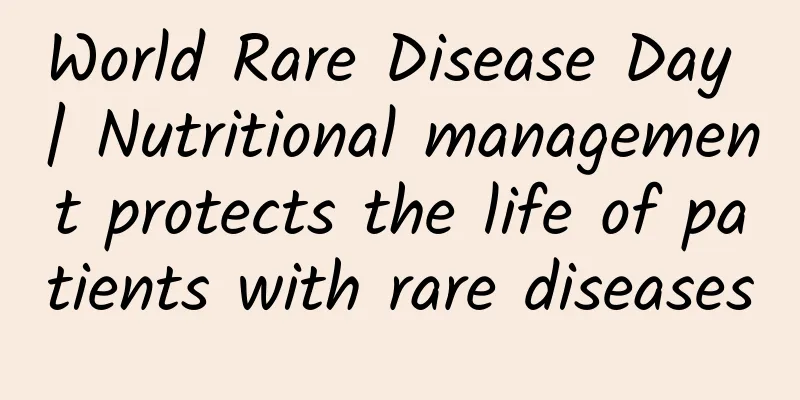World Rare Disease Day | Nutritional management protects the life of patients with rare diseases

|
Although "rare" seems to be far away from us, there are more than 8,000 rare diseases worldwide, affecting as many as 300 million people. There are about 20 million rare disease patients in China, half of whom are children. In the field of comprehensive treatment of rare diseases, nutritional management plays an important role. Why are nutritionists needed for the treatment of rare diseases? Many rare diseases (especially inherited metabolic diseases) involve metabolic abnormalities, and dietary management and metabolic improvement of patients are important components of treatment. At this time, professional nutritionists become an indispensable part. The goal of nutritional treatment for inherited metabolic diseases is to reduce the intake of food that may aggravate metabolic problems through nutritional management, while ensuring that patients can take in a balanced diet and maintain a healthy state, especially in the long life stage from infancy, childhood to adulthood. Nutritional intervention is an important basis for treatment. What do international guidelines recommend? International guidelines suggest that patients with rare diseases need personalized dietary treatment and regular follow-up. The goal of these special diets is not only to restrict foods that will aggravate the condition, but also to ensure that the patient's nutrition is balanced and help them maintain normal growth and health. The relevant guidelines of the American Society of Enteral and Parenteral Nutrition have suggested that nutrition experts must be core members of the genetic metabolic disease treatment team and provide patients with regular dietary guidance, education and follow-up services. Under what circumstances do rare diseases require nutritional support? 1. Nutritional treatment targeting disease characteristics: Some rare diseases (especially genetic metabolic diseases) can cause various problems due to metabolic disorders in the body, such as enzyme deficiency, accumulation of metabolic intermediates, or abnormal nutrient metabolism. In these cases, scientifically adjusting the diet can effectively help patients relieve symptoms and even improve their condition. For example: Glycogen storage disease: Patients are prone to hypoglycemia. By supplementing raw corn starch as a source of carbohydrates, blood sugar can be stabilized, symptoms such as liver enlargement can be alleviated, and survival time can be prolonged. Hyperphenylalaninemia: A low-protein diet can reduce the damage to the nervous system caused by protein metabolism disorders. Wilson's disease: A low-copper diet can reduce the accumulation of copper in the body and alleviate the condition. Prader-Willi syndrome: A low-salt, low-fat, calorie-restricted diet can help control obesity and its complications. 2. Provide support for long-term treatment: Most patients with rare diseases require long-term or even lifelong management. As the disease progresses, many patients will suffer from physical exhaustion due to the disease, their nutritional status will gradually decline, and they will experience problems such as weight loss, fatigue, and even muscle loss. In this case, nutritional support is particularly important. For example, in patients with amyotrophic lateral sclerosis (ALS, also known as Lou Gehrig's disease), in addition to progressive muscle atrophy, swallowing and breathing difficulties, they are often accompanied by a gradual decline in nutritional status, weight loss, fatigue, and loss of lean body tissue. If nutritional support is strengthened, it can help patients delay physical decline, improve quality of life, and even prolong survival time. (Author: Li Rongrong, Department of Clinical Nutrition, Peking Union Medical College Hospital, Chinese Academy of Medical Sciences) |
<<: Deciphering 16 unknown secrets of diabetes diagnosis, most diabetics are unaware of it!
>>: World Rare Disease Day | Primary myelofibrosis: a rare disease that often affects the elderly
Recommend
What are the correct methods for chin augmentation?
Everyone loves beauty. With the development of te...
What can be mixed with hawthorn to drink? How to eat fresh hawthorn
Hawthorn has a very high nutritional value, conta...
What if my period comes 12 days early?
Nowadays, many women have their periods come earl...
What are the signs and symptoms of pregnancy in the first week?
Many women are particularly interested in knowing...
Can an ectopic pregnancy be saved?
Ectopic pregnancy can be said to be very harmful ...
What are the symptoms of postpartum intestinal obstruction?
After giving birth, the space in a woman's ab...
Is it normal to have trouble sleeping during early pregnancy?
Many female friends will encounter some problems ...
What should I do if my vagina is itchy and has excessive vaginal discharge?
Itching of the vaginal opening and excessive vagi...
What causes back pain in late pregnancy?
Pregnant women need to pay more attention in the ...
Can women eat bananas during menstruation?
Every woman has her menstrual period every month....
What to do about stretch marks after giving birth
Every woman wants to have good skin, even mothers...
Qimai Research Institute: Ranking of popular mobile applications in April 2023
Recently, Qimai Data released the popular applica...
Skin care methods for 30-year-old women
Skin care requires long-term maintenance. Many wo...
What is the reason for women's long-term bad breath
The problem of bad breath is a headache for many ...
How old is a girl's period?
When girls enter puberty, their bodies undergo si...

![[Fat Bear Science] Cancer gene testing | Oncologists summarize 10 issues that people are particularly concerned about in clinical practice](/upload/images/67f1ecaae8d17.webp)







